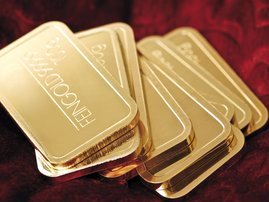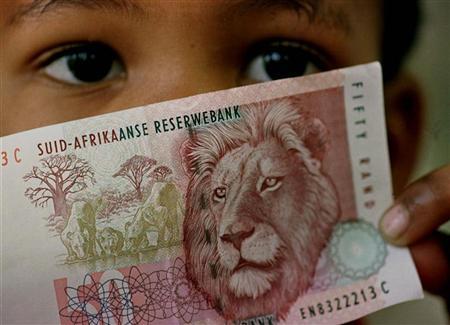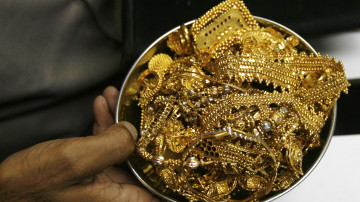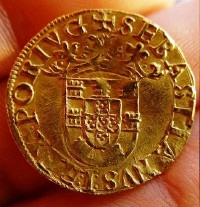G20 pledge helps push gold to new high
G20 pledge helps push gold to new high
Gold prices hit a fresh record above $1,100 this lunchtime after a pledge by G20 countries to keep economic recovery pumped up with emergency stimulus measures.
In London, gold struck an all-time peak of $1,111.20 an ounce. The move came as the euro earlier rose to $1.50 for the first time in two weeks.
The International Monetary Fund also said on Saturday that emergency stimulus measures must remain to avoid endangering an emerging economic recovery.
Last week, the US Federal Reserve decided to hold rock-bottom US interest rates for 'an extended period' and to keep trillion-dollar stimulus measures in place to support the US's fragile recovery from recession.
The precious metal had on Friday reached above $1,100 for the first time, following news that Sri Lanka had joined India in purchasing gold in favour of the US currency. The IMF last week said it had carried out a massive sale of the precious metal to India.
S.Africa's rand hits 2-week high vs dlr

JOHANNESURG (Reuters) - South Africa's rand gained over 1.7 percent against the dollar on Monday as the greenback fell broadly and gold climbed to a record high.
The rand was trading at 7.4040 against the dollar at 1256 GMT, after earlier touching 7.3970, its firmest level since October 23. It closed at 7.5315 on Friday.
The dollar weakened against major currencies while gold -- a major South African export -- hit a record high of $1,110.85 an ounce.
India Buys Gold from International Monetary Fund to Diversify Foreign Exchange Reserves

India has purchased 200 tons of gold from the
International Monetary Fund to diversify its foreign exchange reserves.
From New Delhi, Anjana Pasricha reports the deal means that India's
Central bank now has the tenth largest gold holdings in the world.
Few had expected India's Reserve Bank to be the first to buy the International Monetary Fund's gold.
India
has snapped up 200 metric tons of gold - nearly half the precious metal
the IMF is selling to shore up its finances and increase lending to
developing countries.
The Reserve Bank has paid $6.7 billion for the gold.
The
addition of 200 tons of gold means that about six percent of the
Reserve Bank's foreign exchange reserves are now in gold, up from four
percent. The country's foreign exchange reserves totaled $285 billion
in October.
India's Finance Minister, Pranab Mukherjee, says the
country's comfortable foreign exchange reserves prompted the Reserve
Bank or RBI to invest in the precious metal.
"Naturally as a
finance minister my advise to the governor of RBI would be that if you
are in a position keeping in view the availability of the foreign
exchange you buy that [gold], and from that perspective it has been
bought," he said.
Economists say India has bought gold to
diversify its assets and hold fewer dollars at a time when the U.S.
currency is weakening against other currencies. Gold, whose prices have
surged in the past year, is seen as a hedge against a slumping dollar.
India, like several Asian countries, holds relatively little gold in proportion to its foreign exchange reserves.
India's
move to buy gold from the IMF is also seen as part of an effort to
assert its greater role in world economic affairs. India, along with
China, has been lobbying for larger representation in the IMF, and has
promised to augment its resources for lending to developing countries.
There is speculation that other Central Banks, including the China's, would buy the rest of the gold the IMF plans to sell.
In
fact, India's gold purchase is reminiscent of another year when the
yellow metal dominated headlines in the country. In 1991, dwindling
foreign exchange reserves forced New Delhi to use its gold reserves to
raise a loan to pay its international debt. The payment crisis marked a
turning point for India's economy as it prompted the government to
reverse decades of closed-door, socialist style economic policies.
Economists
say India's purchase of 200 tons of gold shows that the country has
come a long way in the two decades since it was on the verge of
defaulting on its international debt.
India is Asia's third largest economy, and it was less affected by the global financial crisis compared to Western countries.
Gold price above VND 26 million per tael

According to the Wall Street Journal, gold futures climbed to new heights in electronic trading this morning in Asia, with the most-active December contract tapping an intraday high of US$1,105 an ounce, as the market extended gains from Friday's record New York finish.
Ongoing concern over global economies continued to boost the precious metal's appeal as a safe-haven investment.
Gold for December delivery, the most-active futures contract, climbed to a contract high of US$1,105.4 an ounce on Globex. It was at US$1,104.3, up US $8.60 by the late afternoon in Tokyo. That surpassed the intraday high of US$1,101.9 on Friday in New York.
Gold is a "very impressive market," said Darin Newsom, Telvent DTN senior analyst. "Following U.S. unemployment data Friday, it is finding plenty of safe-haven buying worldwide on the idea global economies may not be as strong as advertised."
U.S. Government figures released Friday showed that the nation's unemployment rate topped 10.2% in October, lifting expectations the Federal Reserve will keep interest rates near zero well into next year, and thus pressuring the US dollar.
Gold nears $1,100 an ounce

Technical momentum builds after Indian gold acquisition, lower dollar also boosts bullion
Gold (GC-FT1,107.3011.601.06%) hit a record high for a second straight day Wednesday, moving within striking distance of $1,100 (U.S.) an ounce as the U.S. dollar dropped broadly after the Federal Reserve said it intended to keep interest rates low for some time.
The dollar weakness against the euro and a basket of major currencies added to momentum triggered by India's purchase of 200 tonnes of gold from the International Monetary Fund.
“The Fed is still looking at the low rates for an extended period of time. The easy monetary policy is here to stay for a little longer. The conditions remain in place for gold to continue to move higher,” said Tom Hartmann, broker at California-based Altavest.
The Federal Reserve on Wednesday expressed growing confidence that a U.S. economic recovery was building, and it committed to keep borrowing costs near zero. It also left benchmark rates unchanged in a range of zero to 0.25 per cent.
“The Fed's reasoning for feeling comfortable with keeping rates low is that it doesn't see inflation fundamentals in the market. That may be true in the classic sense of inflation, but if we look at how the falling dollar is affecting commodity prices, that is inflation,” Mr. Hartmann said.
Spot gold struck a high of $1,097.25 an ounce after the Fed statement, and was last at $1,096.45 an ounce at 3:25 p.m. ET against $1,084.50 late in New York on Tuesday.
Traders also cited strong sentiment after the IMF said earlier this week that it had sold 200 tonnes of gold to the Reserve Bank of India, half of a long-planned bullion sale that had threatened to slow gold's ascent.
“India has [prompted] new speculation of pent-up demand for gold diversification by central banks,” said Michael Lewis, head of commodities research at Deutsche Bank.
Weakness in the dollar has added to this momentum, dealers said. The dollar index fell in choppy trade against the euro after the Fed statement.
Gold typically moves in the opposite direction of the dollar. Strength in the U.S. unit makes gold, like all dollar-priced commodities, more expensive for holders of other currencies and cuts its appeal as an alternative asset.
Spot gold prices also rose to an eight-month peak in euro terms at €741.77 ($1,103.22), and hit their highest since early June when denominated in Australian dollars, at $1,206.74 ($1,097.26).
Before the Fed's interest rate decision, U.S. December gold futures settled up $2.40 at $1,087.30 an ounce on the Comex division of the New York Mercantile Exchange.
Demand for physical gold showed some signs of life, with holdings of the largest bullion exchange-traded fund, New York's SPDR Gold Trust, rising nearly five tonnes.
As gold prices reached record highs on Wednesday, long-time technical analyst Robert Prechter said the rally is overdone. Mr. Prechter is known for predicting the 1987 stock market crash.
Among other precious metals, spot silver (SI-FT17.680.301.73%) rose to $17.46, tracking gains in gold, against $17.20. Platinum (PL-FT1,368.6020.401.51%) was at $1,367 an ounce against $1,355.50.
Palladium (PA-FT335.604.901.48%) rose to $327 after stronger-than-expected U.S. car sales numbers late on Tuesday, against $324.50 late in the previous session in New York.

Perhaps the most significant news involving gold in the past week was the pattern of gold trading after last Friday’s Bureau of Labor Statistics announcement of the U.S. unemployment rate.
According to the BLS, the U-3 definition of the unemployment rate had jumped 54.5 percent in the past 12 months to 10.2 percent. This is the most commonly reported unemployment rate.
The BLS also reported that the U-6 definition of unemployment had climbed 45.8 percent from a year ago to its current level of 17.5 percent.
As those who have read my past columns understand, both of these reported figures understate U.S. unemployment. According to John Williams’ Shadow Government Statistics , using the BLS methodology before it was changed under President Clinton, the current U.S. unemployment rate is about 22 percent.
A poor unemployment report reflects negatively on the U.S. economy with the result that the U.S. Treasury would have to pay a higher interest rate on its debt. One way to offset the poor unemployment news would be by having the U.S. dollar show strength against the price of gold (i.e., having the price of gold drop).
The U.S. unemployment report matters to the gold market because of the regular pattern of U.S. government gold price suppression coincident with the release of this data. Of the previous 50 monthly reports, almost all showing a rising unemployment rate, the gold’s price has been clobbered 48 times almost exactly as the reports were released. Gold often took a few weeks to return to the pre-suppression levels. In the past year, however, the price suppression has had a shorter term effect.
Last Friday, With the release of the data, the price of gold actually kept increasing. As it neared $1,100, price suppression tactics kicked in. First, the price of gold was knocked down about $10 almost instantly, not long after the London p.m. fix was set. A price suppression effort right after announcement of the London p.m. fix is one of four standard times during the day that the manipulations tend to occur.
The gold market shrugged off this sudden drop. Prices started to rise again towards $1,100. As it neared that level, another attack quickly knocked down the gold price by $7. After this, the gold price again started to climb, closing on the COMEX just under $1,097, a new high (ignoring inflation). The ACCESS market, which begins trading a half hour after the COMEX closes, saw gold prices reach the $1,100 level at one point last Friday.
When Asian markets began trading Monday morning (Sunday night in the U.S.) the price of gold quickly topped $1,100 and stayed there during European markets. It remained above that level in U.S. trading on Monday.
Now that gold has reached $1,100, what next?
For the next two weeks, there are relatively few economic developments that would call for the aggressive manipulation downward of the gold price. It is possible that the price of gold may see significant gains soon. The reasons behind the rise in the gold price, despite tremendous suppression efforts over many years, have not been cured or resolved. In fact, the economic conditions have gotten worse. So, while it is always possible for a temporary profit-taking retrenchment in the price of gold, the prospects are overwhelmingly in favor of much higher prices in the near future rather than any long term decline.
The references to the price of gold rising to all-time record high levels are misleading. There has been significant inflation since gold peaked at $850 in early 1980. Using the current government statistics on inflation, the price of gold would have to reach (depending on whose calculation you use) somewhere between $2,100 and $2,600 just to match the 1980 record of $850. John Williams, whose work I cited above, notes that the U.S. government has changed the way it calculates the fluctuation in consumer prices. By his calculation, using the government’s 1980 methodology, the price of gold would have to reach about $6,500 to really represent a record high price.
When you realize that the price of gold, even at $1,100, is still far below its inflation-adjusted past record high, you can more easily understand why the price of gold has a lot of potential for a major increase.
David C. Harper, editor of Numismatic News recently posted a column on Numismaster where he related an e-mail exchange between someone concerned that my own columns were too much gloom and doom and also too politically oriented. You have to put my columns in context. People with significant investments in gold or silver have been generally very happy for several years. When customers are selling their precious metals lately, they are almost all cheerful at the profits they are realizing (of course, you have to keep the effects of inflation in mind).
I became a coin collector in 1964, as did almost everyone in my family. After sorting some silver coins out of change, I made my first gold and silver bullion-coin purchases from a coin dealer in 1973. I realized a huge profit when I cashed out in 1980. My ability to make a profit trading precious metals is one reason I became a coin dealer myself in 1981. I profited by avoiding purchases when the market was weak (most of the 1980s and 1990s) and by swapping between gold and silver when the ratios went to extremes.
My company’s past newsletters have frequently included selling or trading recommendations. For instance, I don’t recall any other coin dealer who matched our recommendation of selling 1982 one- ounce gold Pandas in August 1987 when they were trading for more than $4,000 each. I have been consistently bullish on gold and silver prospects for the past several years during a time when their price increases have far surpassed that of the stock markets or the value of the U.S. dollar.
After carefully studying a myriad of factors that affect precious metals markets, I remain just as bullish today as I have been for the past several years. However, I reject the label of “gold bug.” I think the ideal form of money should be decided by the free market rather than by politicians. It just so happens that gold and silver have proved to be a nearly ideal form of money over thousands of years. We are approaching a time when they again may play a major monetary role. But I don’t know that precious metals will always be an ideal form of money.
As for being political, I have consistently attacked bad government policies no matter which politician has been in office. As I understand the American political system, I don’t think it makes that much difference which of the two major presidential candidates wins the election, as the general results will be roughly the same no matter who holds the office. My objections to political actions are based on their content, not the identity of the particular politician.
By the way, my bullish expectations for gold and silver do not carry over to platinum or palladium. So, I don’t recommend all of the standard precious metals. While platinum and palladium may appreciate from now into the future, I expect gold and silver to far outperform them. Even though the price of gold has topped $1,100, don’t start cheering until at least $1,500.
P.S. The other three times during the day that you tend to see gold price suppression efforts are 1.) at the opening of the London market (4 a.m. EST/3 a.m. EDT); 2.) whenever some particularly horrible economic news is being released by the U.S. government, and 3.) during the thinly traded ACCESS market after 2 p.m.